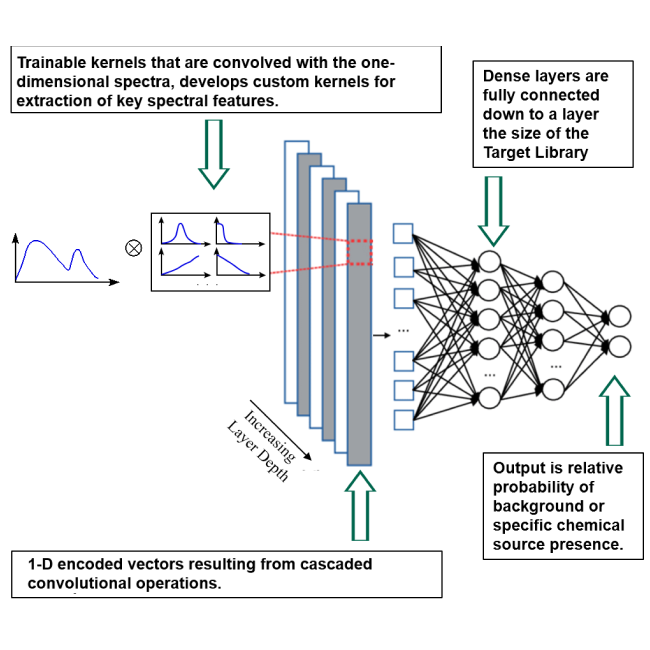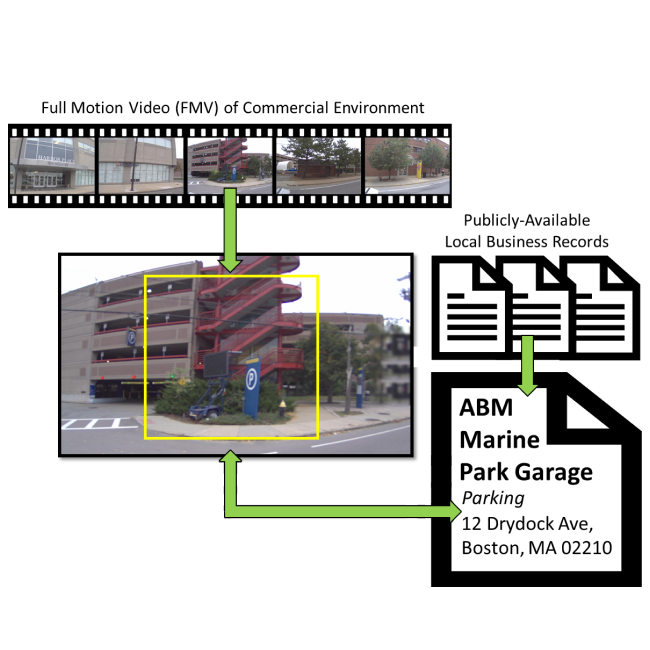
Advanced mathematical frameworks for threat detection and identification
Deep-learning based spectroscopic analysis
SpecInsight (Tier 0)
High-Performance Spectral Analysis
SpecInsight is an advanced spectral identification technology that utilizes a custom deep convolutional neural network to enhance the sensitivity and specificity of spectral analysis for target detection and identificaiton. Unlike traditional statistical approaches, SpecInsight considers both the characteristic sensor noise profile, as well as the similarities and differences in spectral signatures across the library. The SpecInsight technology uses vast amounts of nominal sensor measurements to characterize sensor variability, background environments, and common clutter. Target signatures are developed from only a few examples, and a custom sensor model is developed to inject representative sensor responses into the nominal background measurements.
SpecInsight has been successfully applied to Ion-mobility Spectrometers (IMS) and has demonstrated 10x increase in sensitivity and 100x reduction in false alarms over native and other state-of-the-art detection approaches. SpecInsight is the core detection and identification algorithm used in PSI’s Chemical Airborne Threat Sensor Suite (CATSS). CATSS is based on a water chemistry configuration of the Bruker RAID-P IMS interfaced with a processing module that executes SpecInsight to enable significantly improved performance against 12 chemical warfare agents (CWAs) and 20 toxic industrial chemicals and precursors. CATSS offers enhanced chemical vapor sensitivity, specificity, and false or clutter alarm rejection. The system is specifically configured to detect and localize a potential threat as early as the synthesis stage, and can be operated as a static node or can be integrated with a mobile platform. CATSS is offered as an add-on chemical detection module for PSI’s PERM-Mobile R/N mobile detection platform.
The core SpecInsight technology is sensor agnostic and PSI is currently working on applying its principles to detection modalities outside of IMS.

An illustration of the SpecInsight analysis method, which leverages a custom deep convolutional neural network to characterize the spectral content of the input spectrum to detect and identify the presence of unique targets.
AI/ML Vision and Language Understanding
Contextual Object Real-time Analysis for Lead Generation (CORAL)
Semantic Reasoning for Contextualizing CBRN Alerts
CORAL algorithms provide contextual understanding of the nearby industrial and commercial activity that contributes to the local chemical and radiological environment. CORAL uses deep AI/ML vision language models to correlate business records and other textual sources of information with imagery recorded from PSI’s integrated chemical and radiological sensor systems. We leverage state-of-the-art AI/ML technology that can determine the correlations between specific passages of texts and regions of imagery. The underlying models are optimized and constrained to the specific domains relevant for understanding the commercial environment. By correlating these information sources in near real-time, the system generates information on which nearby businesses are operating, their level of activity, and the likely emissions they will generate. This capability will significantly reduce the operational burden of deploying mobile CBRN sensor platforms. The majority of sources detected by these sensors in urban environments are caused by normal background variability, including commercial and industrial activity associated with well-labeled vehicles and businesses. By automatically correlating imagery and public records, many alerts can be deprioritized or potentially automatically adjudicated. CORAL algorithms are currently under testing and evaluation via integration with our operationally deployed PERM-Mobile CBRN systems.

CORAL analyzes real-time imagery and textual records (such as business registration data) to provide a deep understanding of nearby commercial activity that may explain the chemical or radiological environment.
Related Products
Static Installations
PERL™ Ecosystem
Mobile Systems
Production, Maintenance, Training and Sustainability
Markets We Serve
Defense and Security
Ensuring the safety and efficacy of our war-fighters and protecting the homeland
Find out moreMedical and Pharma
Translating new technologies to clinical and industrial applications for improved health care
Find out moreEnergy and Environment
Clean energy technologies and sensors for addressing climate change challenges
Find out more